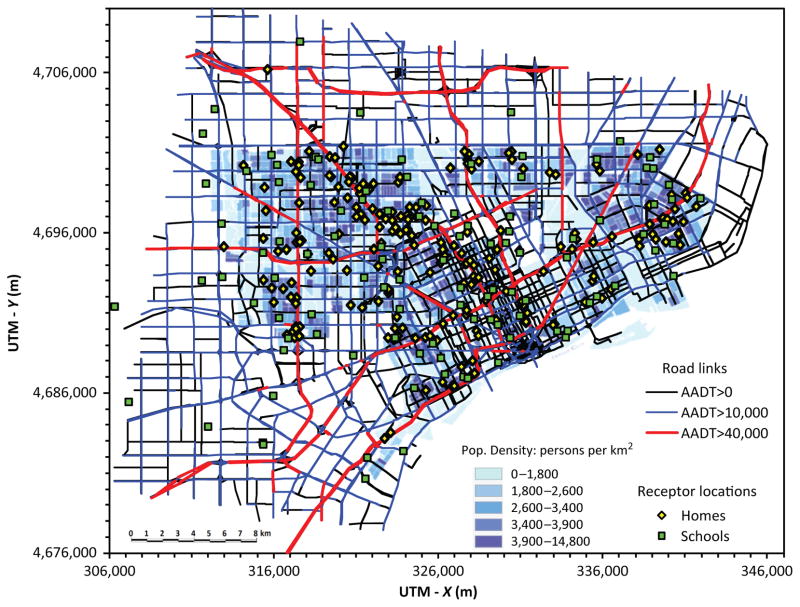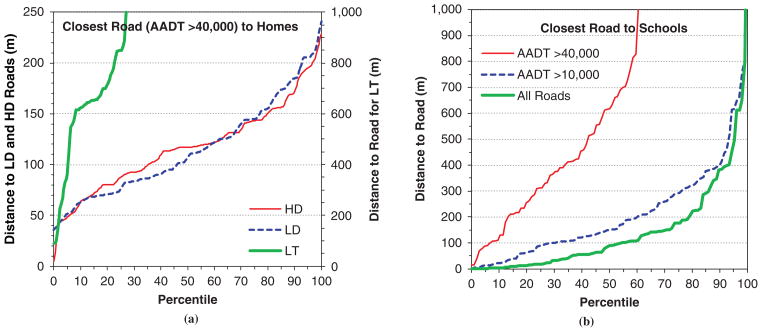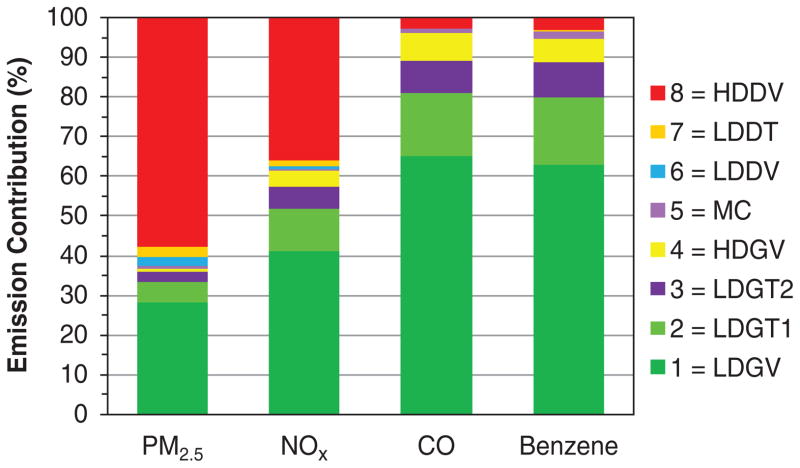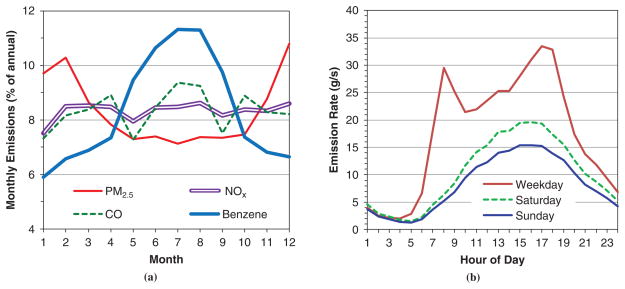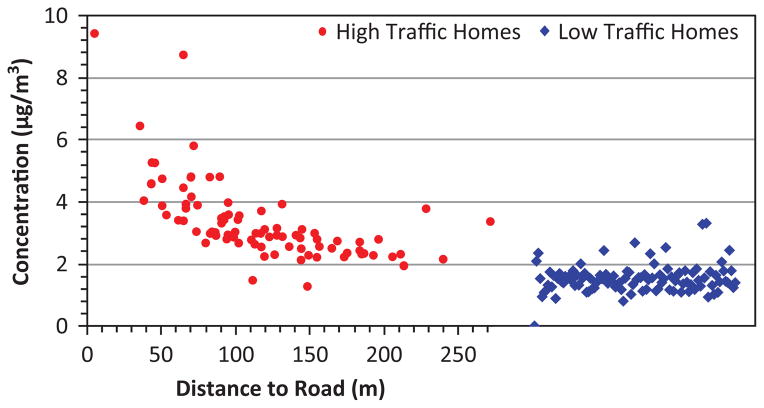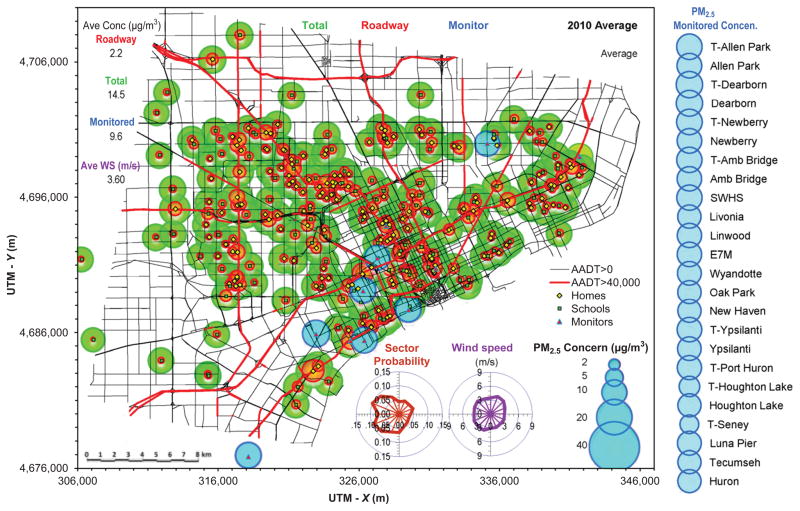Abstract
Vehicular traffic is a major source of ambient air pollution in urban areas. Traffic-related air pollutants, including carbon monoxide, nitrogen oxides, particulate matter less than 2.5 μm in diameter, and diesel exhaust emissions, have been associated with adverse human health effects, especially in areas near major roads. In addition to emissions from vehicles, ambient concentrations of air pollutants include contributions from stationary sources and background (or regional) sources. Although dispersion models have been widely used to evaluate air quality strategies and policies and can represent the spatial and temporal variation in environments near roads, the use of these models in health studies to estimate air pollutant exposures has been relatively limited. This paper summarizes the modeling system used to estimate exposures in the Near-Roadway Exposure and Urban Air Pollutant Study, an epidemiological study that examined 139 children with asthma or symptoms consistent with asthma, most of whom lived near major roads in Detroit, Michigan. Air pollutant concentrations were estimated with a hybrid modeling framework that included detailed inventories of mobile and stationary sources on local and regional scales; the RLINE, AERMOD, and CMAQ dispersion models; and monitored observations of pollutant concentrations. The temporal and spatial variability in emissions and exposures over the 2.5-year study period and at more than 300 home and school locations was characterized. The paper highlights issues with the development and understanding of the significance of traffic-related exposures through the use of dispersion models in urban-scale exposure assessments and epidemiology studies.
Vehicles are a major source of air pollutants, including oxides of nitrogen (NOx), carbon monoxide (CO), particulate matter (PM) less than 2.5 μm in diameter (PM2.5), and volatile organic compounds (VOCs) (1, 2). Because vehicle emissions are released at or near ground level and mostly in urban areas, exposure to traffic-related air pollutants is widespread. Exposure to traffic-related air pollutants has been associated with a range of adverse health effects, such as exacerbation of asthma, asthma onset, impaired lung function, cardiovascular morbidity and mortality, adverse birth outcomes, and cognitive decline (3–5).
Vulnerable individuals who are particularly susceptible to the adverse health impacts of traffic-related air pollutants because of personal, environmental, and socioeconomic factors include the young and the elderly; individuals with existing cardiovascular or respiratory diseases, such as asthma; and individuals living, working, or frequenting locations near roads with high levels of traffic. Many individuals living in high-traffic areas are nonwhite and low income (6), characteristics that are associated with susceptibility to the adverse effects of air pollution. In the United States, an estimated 40 million people live within 100 m of major roads, railways, or airports (7), and millions more commute on major roads, suggesting the importance of exposure to traffic-related air pollutants for public health.
A major challenge for scientific investigations of the health impacts of traffic-related air pollutants is the lack of information on pollutant exposure. Data provided by networks monitoring ambient air quality, including the new near-road monitoring network (8), are helpful for understanding pollutant exposure; however, these networks are not designed to provide the spatial coverage and often the temporal resolution needed to evaluate population exposures to traffic-related air pollutants. In particular, traffic-related air pollutants found at elevated levels near roads, including PM2.5, ultrafine PM (which is currently unregulated), VOCs, nitric oxide, and polycyclic aromatic hydrocarbons, demonstrate steep gradients in concentrations and typically reach background levels at distances of 150 to 200 m from the road (9–16).
Most epidemiology studies have relied on several approaches to estimate exposures due to traffic, mostly proximity-, geographic information system-, or interpolation-based methods. Although they are often useful for analyses of health effects, these methods result in surrogates or indicators of exposure that do not capture the temporal patterns (e.g., diurnal, weekday or weekend, and seasonal trends) demonstrated by traffic-related air pollution. The use of personal exposure measurements, exposure biomarkers, or sufficiently localized indoor or ambient monitoring measurements is, unfortunately, not feasible or practical, given the number of subjects and the duration of most health studies, as well as other limitations. Thus, the need for methods and data to obtain more accurate temporally and spatially resolved information on exposures to traffic-related air pollutants remains. Reductions in the spatial and temporal errors in exposure estimates for subjects in epidemiology, risk assessment, and other types of studies (17–19) will allow such information to improve significantly understanding of the health effects associated with traffic-related air pollutants.
OBJECTIVES
The Near-Road Exposures to Urban Air Pollutant Study (NEXUS) is investigating whether children with asthma living in close proximity to major roadways in Detroit, Michigan, experience greater health impacts associated with air pollutants than those living farther away, particularly near roadways with high levels of diesel traffic (20). NEXUS is using air quality modeling to estimate exposures for the children that reflect the complex and often dramatic spatial and temporal patterns associated with traffic-related air pollutants. A broader discussion of the scope of NEXUS is provided elsewhere (20).
This paper summarizes the modeling system used to estimate ambient pollutant concentrations in NEXUS. It describes the development of a comprehensive inventory from mobile and stationary sources, dispersion modeling of local and regional sources, and its application to the health study. This paper emphasizes the temporal and spatial variability of exposures in NEXUS, the differences between alternate exposure metrics, and the use of simulation models to provide daily estimates of pollutant exposures and source apportionments compared with those from statistical land use regression models that provide long-term averages. The present paper is relevant to urban-scale dispersion modeling of air pollutants, and it focuses on the derivation of exposures of traffic-related air pollutants that are applicable to both risk and epidemiology studies.
METHODS
Study Population and Health Assessment
NEXUS is a community-based participatory research study designed to examine the relationship between exposures to air pollutants near roadways and adverse respiratory health outcomes in a cohort of asthmatic children who live close to major roadways in Detroit. A community-based steering committee was established, and the study design and protocols were developed with the committee’s input and consent. Children ages 6 to 14 years with asthma or symptoms of asthma were recruited to participate in the study on the basis of the proximity of their homes to major roads in three traffic categories: (a) homes near high traffic and high-diesel traffic, defined as homes within 150 m of roads with >6,000 commercial vehicles per day (commercial annual average daily traffic) and >90,000 total vehicles per day [annual average daily traffic (AADT)]; (b) homes near high traffic and low-diesel traffic, defined as homes within 150 m of roads with >90,000 AADT and <4,500 commercial vehicles per day; and (c) homes near roads with low traffic, defined as homes located >300 m from roads with >25,000 AADT and greater than 500 m from roads with >90,000 AADT.
To minimize possible confounding from unmeasured neighborhood-associated covariates, children whose homes were in the low-traffic group were drawn from the same neighborhoods and school catchment areas as those whose homes were in the high-diesel and low-diesel segments but lived farther from the high-traffic corridors. A total of 139 children were enrolled and participated in NEXUS from September 2010 to December 2012, and the distributions across the three traffic categories were approximately equal. The study population was predominantly minority: non–Hispanic blacks constituted 82% of the participants, Hispanics constituted 8%, non–Hispanic whites constituted 4%, and individuals of other races or multiracial individuals constituted 6%. Many households were poor, and a third of the families reported annual household incomes of less than $15,000.
During the course of the study, a number of children moved, and the evaluation used all residences reported for the children. Because of the moves, a total of 218 residence locations were considered. Each location was geographically coded by use of a handheld GPS unit placed near the front door of each residence. These children attended 107 schools, which were similarly geographically coded.
Respiratory health effects potentially associated with exposures to traffic-related air pollutants were characterized on a seasonal basis over a 14-day period for each child. Health measures evaluated included asthma aggravation (lung function and symptoms), inflammation and oxidative stress responses (exhaled nitric oxide and nasal cytokines), and respiratory viral infections (frequency, severity, and type). Seasonal assessments also included the collection of information on medication and health care use and diary reports of symptoms of upper respiratory tract infection, determination of the fraction of exhaled nitric oxide and urinary F2-isoprostane levels, and the collection of nasal lavage samples. Information on means of asthma control and symptoms associated with obstructive sleep apnea was also obtained.
Hybrid Dispersion Modeling
Air pollutant concentrations and exposures for the children in NEXUS were estimated by use of dispersion models, including AERMOD (21, 22) and RLINE (23, 24). RLINE is a research-level, line source dispersion model being developed by the U.S. Environmental Protection Agency’s Office of Research and Development as a part of the ongoing effort to further develop tools for the comprehensive evaluation of the impacts of air quality in the environment near roads.
Traffic activity and primary mobile source emissions were estimated to produce a spatially and temporally resolved mobile source emissions inventory giving hourly pollutant emissions by vehicle class and road link, as described elsewhere (25, 26). Road network data, obtained from the Southeast Michigan Council of Governments, included link locations, number of lanes, roadway type (e.g., freeway, arterial), AADT, and average speed (for four periods over the day) for each of 9,701 links. The traffic activity by vehicle class was based on travel demand models with input by the U.S. Environmental Protection Agency and the Michigan Department of Transportation. AADT values were allocated to eight vehicle classes (e.g., heavy-duty diesel, light-duty gasoline) and adjusted to obtain hourly estimates by the use of month-of-year, day-of-week, and hour-of-day temporal allocation factors on a link-specific basis. Whenever possible (mainly for Interstates), estimated vehicle flows were checked against monitored traffic counts. Emission factors representative of vehicle classes in the study area were calculated through the use of the MOVES2010a mobile source emissions model as a function of average speed, ambient temperature, season, and road type.
Stationary sources of pollutants, such as stacks from manufacturing facilities, were modeled by the use of AERMOD, source locations, emission rates, and other information obtained from the latest (2008) official National Emissions Inventory. The regional background contribution was estimated using a combination of the Community Multiscale Air Quality (CMAQ) model and the Space/Time Ordinary Kriging model. Two CMAQ model simulations were conducted: the baseline simulation represented all emissions in a broad region (covering the eastern United States), and the second removed all anthropogenic emissions in the NEXUS study domain. The ratios of the concentrations predicted by CMAQ in these two simulations in the Detroit region along with air quality system measurements in the region were used to estimate background pollutant concentrations at the NEXUS study locations.
The modeling provided hourly pollutant concentrations for CO, NOx, PM2.5, and benzene. The hourly concentrations were processed to calculate daily and annual average exposure metrics for each study participant’s home and school location for use in the epidemiologic analyses.
RESULTS
Study Region and Road Network
Figure 1 shows the study area, including the locations of the homes of the children in NEXUS and the schools that they attend, and the modeled road network. The city of Detroit covers 355 km2; the road network (shown in Figure 1) covers nearly 800 km2. The road network extended at least 5 km beyond the locations of the NEXUS homes. A few children attended schools at the periphery of or outside the modeled area.
FIGURE 1.
Modeled road network in Detroit area containing 9,701 links and locations of 218 homes and 107 schools of participants in NEXUS (shaded area = city of Detroit; pop. = population; UTM = universal transverse Mercator units).
The modeled road network is summarized in Table 1. It consisted of 9,701 links representing 3,109 km of roads, including all but the smaller and numerous local roads. Major roads were frequently represented by the use of multiple links at any particular location; that is, Interstate highways were represented by the use of separate links for each direction as well as each service road (Table 1 reflects this classification).
TABLE 1.
Summary of Modeled Road Network in Detroit
| NFC | Road Type | Segment
|
Road Length
|
Lane Length
|
Average AADT (vph) | VKT
|
||||
|---|---|---|---|---|---|---|---|---|---|---|
| Count (no.) | Fraction (%) | Total km | Fraction (%) | Total (km) | Fraction (%) | Total (KT * 1,000) | Fraction (%) | |||
| 11 | Interstate | 967 | 10.0 | 453 | 14.6 | 1,195 | 13.0 | 30,370 | 11,887 | 34.3 |
| 12 | Other freeway | 368 | 3.8 | 155 | 5.0 | 403 | 4.4 | 32,729 | 4,216 | 12.2 |
| 14 | Other principal arterial | 2,952 | 30.4 | 894 | 28.8 | 3,388 | 36.9 | 19,189 | 10,958 | 31.6 |
| 16 | Minor arterial | 2,465 | 25.4 | 744 | 23.9 | 2,314 | 25.2 | 11,082 | 5,446 | 15.7 |
| 17 | Major collector | 2,786 | 28.7 | 775 | 24.9 | 1,739 | 18.9 | 4,629 | 2,139 | 6.2 |
| 19 | Minor collector | 52 | 0.5 | 16 | 0.5 | 31 | 0.3 | 2,818 | 20 | 0.1 |
| 90 | Bridge | 3 | 0.0 | 2 | 0.1 | 8 | 0.1 | 17,792 | 7 | 0.0 |
| 0 | Other | 108 | 1.1 | 71 | 2.3 | 102 | 1.1 | 0 | 0 | 0.0 |
| Total | 9,701 | 100.0 | 3,109 | 100.0 | 9,179 | 100.0 | na | 34,674 | 100.0 | |
Note: Count is number of links. Length is link based and is provided in kilometers. Lane length is number of kilometers of traffic lanes. no. = number; vph = vehicles per hour; NFC = national function class using Michigan Department of Transportation designations; VKT = vehicle kilometers traveled per day; na = not applicable.
Proximity of Homes and Schools to Roads
By design, many of the children in NEXUS lived very close to major roads. Figure 2a shows the distribution of home-to-road distances for the larger roads. When children in homes recruited near high-traffic roads are considered, the median distances were 117 and 107 m in the high-diesel and low-diesel categories, respectively. One house was as close as 5 m from a high-traffic road. The distributions of home-to-road distances in the high- and low-diesel categories were similar. When all 218 home locations are considered, the median home-to-road distance for links with AADT exceeding 40,000 (typically, one direction on a high-traffic road) was 326 m. This included many homes in the low-traffic category, which were at least 500 m from high-traffic roads.
FIGURE 2.
Distribution of (a) 218 residence-to-road distances for road links with AADT >40,000, grouped by initial classification of the home as high diesel (HD), low diesel (LD), and low traffic (LT) (home classifications are preliminary and based on initial geographically coded estimates from ArcGIS), and (b) 107 school-to-road distances for road links with AADTs >40,000 or >10,000 and all roads.
Figure 2b shows the distribution of school-to-road distances. The median distance to major roads (road links with AADT of >40,000) was 617 m. However, a subset of schools was much closer; for example, 13% were within 200 m and 8% were within 100 m. The closest school was only 14 m from a high-traffic road.
The distributions of home and school distances to roads depicted in Figure 2 indicate that the exposure assessment must address a wide range of conditions, including exposures at some homes and schools that are very close to major roads. They also suggest that children in a particular exposure category, for example, areas with high-diesel traffic, are likely to experience a range of traffic-related exposures and health impacts, given the large range of distances represented in an exposure category, for example, 5 to 200 m; that is, exposures within an exposure category are not homogeneous.
Traffic-Related Emissions
Emission totals for four pollutants by road type are shown in Table 2. For example, the total PM2.5 emissions from all road links are 473 tons per year (the product of annual average emission rates and link lengths summed across all links). As a check, PM2.5 emission results were compared with the emission inventories compiled for Wayne County, Michigan, and southeast Michigan as part of the State Implementation Plan. In 2005, primary on-road PM2.5 emissions in Wayne County (which has an area slightly larger than that of Detroit) were estimated to be 792 tons per year (27). In the seven-county southeast Michigan region, the 2008 inventory gives a vehicle population of 3.65 million, 44.2 billion vehicle miles traveled, and PM2.5 emissions of 4,360 tons per year; but PM2.5 emissions are projected to drop to 1,633 tons per year in 2018 (28).
TABLE 2.
Annual 2010 Total Emission Estimates for NEXUS Road Network Inventory
| NFC | Road Type | PM2.5
|
NOx
|
CO
|
Benzene
|
||||
|---|---|---|---|---|---|---|---|---|---|
| Tons/Year | Percentage | Tons/Year | Percentage | Tons/Year | Percentage | Tons/Year | Percentage | ||
| 11 | Interstate | 94.0 | 19.9 | 2,923 | 19.9 | 8,766 | 15.6 | 14.03 | 14.2 |
| 12 | Other freeway | 108.0 | 22.8 | 3,837 | 26.1 | 14,980 | 26.6 | 23.77 | 24.1 |
| 14 | Other principal arterial | 147.8 | 31.2 | 4,471 | 30.4 | 18,850 | 33.4 | 34.68 | 35.2 |
| 16 | Minor arterial | 74.1 | 15.6 | 2,234 | 15.2 | 9,442 | 16.8 | 17.40 | 17.6 |
| 17 | Major collector | 49.1 | 10.4 | 1,238 | 8.4 | 4,275 | 7.6 | 8.62 | 8.7 |
| 19 | Minor collector | 0.5 | 0.1 | 13 | 0.1 | 46 | 0.1 | 0.09 | 0.1 |
| 90 | Bridge | 0.0 | 0.0 | 0 | 0.0 | 0 | 0.0 | 0.00 | 0.0 |
| 0 | Other | 0.0 | 0.0 | 0 | 0.0 | 0 | 0.0 | 0.00 | 0.0 |
| Total | 473.40 | 100.0 | 14,715 | 100.0 | 56,358 | 100.0 | 98.59 | 100.0 | |
This region is considerably larger than the NEXUS study area; for example, the number of vehicle miles traveled in the study area is only 17% of that in the seven-county area. Although these various estimates use different time periods, different regions, and different models (MOBILE6 and MOVES mobile source emissions models), the NEXUS emission estimates appear to be consistent and reasonable with respect to the State Implementation Plan inventory.
A breakdown of the Detroit emission inventory is shown in Figure 3. Figure 3 indicates that heavy-duty diesel vehicles (HDDV) are responsible for 58% of PM2.5, 36% of NOx, and 3% of CO and benzene emissions. In contrast, light-duty gasoline vehicles (LDGV) emit 28% of PM2.5, 41% of NOx, 65% of CO, and 63% of benzene. These percentages represent the average contribution across the Detroit network for calendar year 2010 and are derived from the modeling system described above.
FIGURE 3.
Fraction of traffic emissions attributable by vehicle class (HDDV = heavy-duty diesel vehicles; LDDT = light-duty diesel trucks; LDDV = light-duty diesel vehicles; MC = motorcycles; HDGV = heavy-duty gasoline vehicles; LDGT2 = light-duty gasoline trucks type 2; LDGT1 = light-duty gasoline trucks type 1; LDGV = light-duty gasoline vehicles).
Temporal Variation of Mobile Source Emissions
The mobile source emission inventory represents the temporal variation at the monthly, daily, and hourly levels. The monthly variation in emission rates for four pollutants is shown in Figure 4a. Trends differ by pollutant, and in some cases, the temporal variation is substantial. PM2.5 emissions are approximately 30% higher during the colder months.
FIGURE 4.
Variation of emissions across Detroit road network: (a) monthly of four pollutants (numbers on x-axis refer to month, e.g., 1 = January, 2 = February) and (b) hourly of PM2.5 emissions for weekdays, Saturdays, and Sundays, averaged across 2010 (numbers on x-axis refer to times on 24-h time system).
Figure 4b shows the hour-to-hour pattern of PM2.5 emissions. Weekdays show a bimodal pattern, reflecting morning and afternoon peak hours, whereas weekends show a single broader afternoon mode. PM2.5 emissions are significantly reduced on weekend days, especially Sundays, reflecting the lower volume of traffic, especially diesel vehicles. The differences between weekday and weekend emissions for CO and benzene are smaller, reflecting the larger share of these emissions emitted by nondiesel vehicles (mostly passenger cars). These diurnal trends reflect the averaging of emissions in each of the eight vehicle classes, which can vary more dramatically by hour and day type. For example, compared with the volume on weekdays, the heavy-duty diesel truck volume is significantly reduced on weekends, the light-duty gasoline vehicle volume is somewhat reduced (the temporal patterns shift dramatically to a single mode), and the motorcycle volume is similar (reflecting an increase in recreational riding). Overall, this analysis indicates the importance of the temporal variation at the monthly, daily, and hourly levels. Furthermore, all road types (as defined by national function class) have essentially similar patterns (data not shown).
Estimated PM2.5 Concentrations at Homes and Schools
This section focuses on the annual average (2010) PM2.5 exposures at homes and schools predicted by the hybrid modeling system described earlier.
Figure 5 shows the annual average PM2.5 levels at the high-traffic homes (both high and low diesel), which are plotted against distance from the classifying road. Figure 5 also shows PM2.5 levels at the low-traffic homes; these homes are unranked by distance (the results are simply plotted in the modeled sequence). The PM2.5 estimates, which include contributions from road, area, point, and regional sources, range from 12 to 24 μg/m3. The concentrations at the high-traffic homes are elevated by an average of 2 μg/m3 above those at the low-traffic homes. As expected, the distance-to-road trend is not strong for total PM2.5 from all sources, yet homes within 100 m of a major road had elevated concentrations.
FIGURE 5.
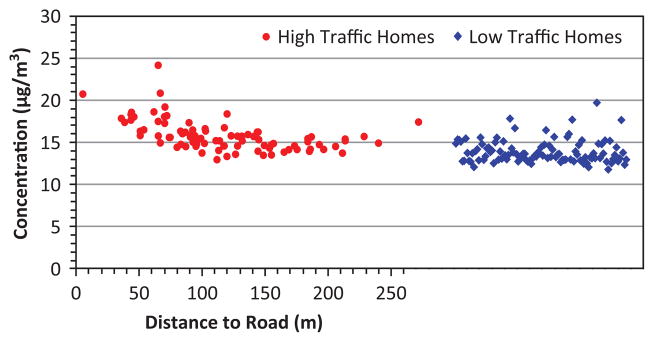
Annual average PM2.5 concentrations at high-traffic homes by distance to road and at low-traffic homes (unranked by distance) (concentrations including contributions from road, nonroad, area, point, and regional sources).
Figure 6 shows annual average PM2.5 levels at high- and low-traffic homes, as in Figure 5, but shows the contributions due to only local (Detroit-area) traffic emissions. In this case, PM2.5 contributions from traffic at the high-traffic homes ranged from 2 to 9 μg/m3, concentrations that are significantly elevated compared with those for the low-traffic homes, most of which received only 1 to 2 μg/m3 from traffic emissions. The concentration–distance trend is strong for the high-traffic homes, although considerable scatter exists. The scatter is produced by the joint effects of multiple roads and road geometry, various levels of traffic and emissions, and meteorology. Each point on Figure 6 indicating an elevated concentration was investigated, and the concentrations were attributable to emissions from one and often several nearby roads.
FIGURE 6.
Traffic-related annual average PM2.5 concentrations at high-traffic homes by distance to road and at low-traffic homes (unranked by distance) (concentrations due only to roadway emissions in Detroit area).
Figure 7 displays the spatial pattern of annual average PM2.5 concentrations at each home and school location, as well as the concentrations monitored at fixed (permanent) sites in the region. At each location, the concentration attributable to traffic emissions is shown as a red circle, and the total concentration (sum of road, non-road, area, point, and regional contributions) is shown as a green circle. The 2010 average monitored concentrations are shown as blue circles. The circle’s area is proportional to the concentration, as indicated in the scale. The left circular plot at the bottom shows the wind direction probability in 16 sectors. The right circular plot at the bottom shows the average wind speed in 16 sectors for the period displayed. The blue circles at the right are concentrations at (named) monitoring sites in Detroit and elsewhere in Michigan (most are off the map). The prefix T denotes measurements obtained by use of a tapered element oscillating microbalance (continuous); otherwise, the sites use measurements obtained by the federal reference method (filter based). (Some sites have both tapered element oscillating microbalance and federal reference method monitors.)
FIGURE 7.
Spatial pattern of annual average PM2.5 concentrations at each home and school location, as well as concentrations monitored at fixed sites in the region (conc and concen = concentration; ave = average; WS = wind speed; SWHS = Southwest High School; E7M = East Seven Mile).
Figure 7 indicates that PM2.5 concentrations are higher near major roadways (red circles), particularly the I-75, M-39, and M-10 corridors, and are present because of traffic. Homes and schools very near major roads, crossings of major roads, or midsized roads can also have elevated levels of traffic-related air pollutants. In contrast, the spatial variation of the total PM2.5 concentration (green circles) is small and is also reflected in the similar levels at most of the monitoring sites (blue circles), largely because of the regional (background) contributions of PM2.5.
Temporal variation is an important factor in air pollutant characterization. It is not displayed in Figure 7. However, maps of the time series of pollutant concentrations are available online (posted at http://www.youtube.com/watch?v=5vZ0lG5T7wc). Movies showing the concentrations for each day in 2010 and 2011 indicate dramatic changes in concentrations.
CONCLUSIONS
This paper has highlighted several key elements in the development and understanding of the significance of traffic-related exposures through the use of dispersion models in an urban-scale exposure and epidemiology application. It has summarized the development and use of a detailed emission inventory and dispersion model to estimate ambient air pollution concentrations. Many exposure metrics can be derived by use of this bottom–up approach, and model outputs can be matched to the desired temporal and spatial resolution. As an example, this paper has discussed both long- and short-term (annual and 24-h average) pollutant concentrations estimated at the homes and schools of the NEXUS participants, a group of children with asthma living near major roads in Detroit; the short-term estimates are designed to match the daily health measures collected for the children.
NEXUS is developing yet more refined exposure measures that account for various rates of air exchange in different types of buildings, the time–activity patterns of study participants, and other factors affecting exposure to air pollutants. This exposure information is being used to investigate the association of traffic-related air pollutants with the measured health outcomes (and this information will be reported subsequently). These analyses will provide further evaluation of the utility of the new exposure metrics and the exposure modeling system.
The modeling system used in NEXUS provides new information on exposure to traffic-related air pollutants. For example, it shows the dramatic spatial and temporal variation of pollutant concentrations attributable to traffic-related emissions, information not captured by simpler exposure metrics, such as traffic intensity and distance to roads. The research findings can ultimately be used by environmental, transportation, and land use planners in developing policies and guidelines that maintain and enhance public health, for example, by determination of appropriate buffers and separation distances between highways and schools, hospitals, and housing and through the establishment of health-protective ambient and emission standards for traffic-related air pollutants.
Acknowledgments
The authors thank Alan Vette, Gary Norris, Steve Perry, and Dave Heist of the U.S. Environmental Protection Agency; Laprisha Berry Vaughn, Sonya Grant, Chris Godwin, Graciela Mentz, Xiaodan Ren, Irme Cuadros, and other staff of the University of Michigan; and Brian Naess, Mohammad Omary, Kevin Talgo, Alejandro Valencia, Yasuyuki Akita, and Marc Serre of the University of North Carolina at Chapel Hill. The authors are grateful to the NEXUS participants and their families who assisted with the collection of these data. Community Action Against Asthma is a community-based participatory research partnership aimed at investigating the influence of environmental factors on childhood asthma. The authors acknowledge the contributions of all partners involved in this collaborative effort: the Arab Community Center for Economic and Social Services, the Community Health and Social Services Center, the Detroit Department of Health and Wellness Promotion, the Detroit Hispanic Development Corporation, Detroiters Working for Environmental Justice, Friends of Parkside, Latino Family Services, Southwest Detroit Environmental Vision, the Warren/Conner Development Coalition, the Institute for Population Health, and the University of Michigan Schools of Public Health and Medicine. The study was conducted with the support of the National Institute of Environmental Health Sciences, National Institutes of Health. The U.S. Environmental Protection Agency, through its Office of Research and Development, partially funded the research described here. The research has been subjected to agency review and approved for publication.
Contributor Information
Stuart Batterman, Environmental Health Sciences, University of Michigan, 1425 Washington Heights, Ann Arbor, MI 48109-2029.
Rajiv Ganguly, Environmental Health Sciences, University of Michigan, 1425 Washington Heights, Ann Arbor, MI 48109-2029.
Vlad Isakov, National Exposure Research Laboratory, U.S. Environmental Protection Agency, 109 TW Alexander Drive, Research Triangle Park, NC 27711.
Janet Burke, National Exposure Research Laboratory, U.S. Environmental Protection Agency, 109 TW Alexander Drive, Research Triangle Park, NC 27711.
Saravanan Arunachalam, Institute for the Environment, University of North Carolina, 100 Europa Drive, Suite 490, Campus Box 1105, Chapel Hill, NC 27711.
Michelle Snyder, National Exposure Research Laboratory, U.S. Environmental Protection Agency, 109 TW Alexander Drive, Research Triangle Park, NC 27711.
Thomas Robins, Environmental Health Sciences, University of Michigan, 1425 Washington Heights, Ann Arbor, MI 48109-2029.
Toby Lewis, Department of Pediatrics, University of Michigan, 1500 East Medical Center Drive, Ann Arbor, MI 48109-5212.
References
- 1.The Contribution of the Transport Sector to Total Emissions of the Main Air Pollutants in 2009 (EEA-32) European Environment Agency; Copenhagen, Denmark: [Accessed March 16, 2013]. http://www.eea.europa.eu/data-and-maps/figures/the-contribution-of-the-transport-1. [Google Scholar]
- 2.U.S. Environmental Protection Agency. National Summary of Nitrogen Oxides Emissions. NEI; 2008. [Accessed April 16, 2013]. http://www.epa.gov/cgi-bin/broker?polchoice=NOX&_debug=0&_service=data&_program=dataprog.national_1.sas. [Google Scholar]
- 3.U.S. Environmental Protection Agency. Integrated Science Assessment for Oxides of Nitrogen—Health Criteria. National Center for Environmental Assessment, Office of Research and Development; Research Triangle Park, N.C: 2008. [Google Scholar]
- 4.Traffic-Related Air Pollution: A Critical Review of the Literature on Emissions, Exposure, and Health Effect. Health Effects Institute; Boston, Mass: 2010. [Google Scholar]
- 5.Laumbach RJ, Kipen HM. Respiratory Health Effects of Air Pollution: Update on Biomass Smoke and Traffic Pollution. Journal of Allergy and Clinical Immunology. 2012;129(1):3–11. doi: 10.1016/j.jaci.2011.11.021. [DOI] [PMC free article] [PubMed] [Google Scholar]
- 6.Tian N, Xue J, Barzyk TM. Evaluating Socioeconomic and Racial Differences in Traffic-Related Metrics in the United States Using a GIS Approach. Journal of Exposure Science and Environmental Epidemiology. 2013;23(2):215. doi: 10.1038/jes.2012.83. [DOI] [PubMed] [Google Scholar]
- 7.Current Housing Reports. U.S. Census Bureau; 2007. [Google Scholar]
- 8.Weinstock L, Watkins N, Wayland R, Baldauf R. Environmental Manager. Air and Waste Management Association; 2013. EPA’s Emerging Near-Road Ambient Monitoring Network—Progress Report; pp. 6–10. [Google Scholar]
- 9.Zhu Y, Kuhn T, Mayo P, Hinds WC. Comparison of Daytime and Nighttime Concentration Profiles and Size Distributions of Ultra-fine Particles near a Major Highway. Environmental Science and Technology. 2006;40(8):2531–2536. doi: 10.1021/es0516514. [DOI] [PubMed] [Google Scholar]
- 10.Hitchins J, Morawska L, Wolff R, Gilbert D. Concentrations of Submicrometre Particles from Vehicle Emissions near a Major Road. Atmospheric Environment. 2000;34(1):51–59. [Google Scholar]
- 11.Karner AA, Eisinger DS, Niemeier DA. Near-Roadway Air Quality: Synthesizing the Findings from Real-World Data. Environmental Science and Technology. 2010;44(14):5334–5344. doi: 10.1021/es100008x. [DOI] [PubMed] [Google Scholar]
- 12.Reponen T, Grinshpun SA, Trakumas S, Martuzevicius D, Wang ZM, LeMasters G, Lockey JE, Biswas P. Concentration Gradient Patterns of Aerosol Particles near Interstate Highways in the Greater Cincinnati Airshed. Journal of Environmental Monitoring. 2003;5(4):557–562. doi: 10.1039/b303557c. [DOI] [PubMed] [Google Scholar]
- 13.Baldauf R, Thoma E, Hays M, Shores R, Kinsey J, Gullett B, Kimbrough S, Isakov V, Long T, Snow R, Khlystov A, Weinstein J, Chen FL, Seila R, Olson D, Gilmour I, Cho SH, Watkins N, Rowley P, Bang J. Traffic and Meteorological Impacts on Near-Road Air Quality: Summary of Methods and Trends from the Raleigh Near-Road Study. Journal of the Air and Waste Management Association. 2008;58(7):865–878. doi: 10.3155/1047-3289.58.7.865. [DOI] [PubMed] [Google Scholar]
- 14.Barzyk TM, George BJ, Vette AF, Williams RW, Croghan CW, Stevens CD. Development of a Distance-to-Roadway Proximity Metric to Compare Near-Road Pollutant Levels to a Central Site Monitor. Atmospheric Environment. 2009;43(4):787–797. [Google Scholar]
- 15.Hagler GSW, Baldauf RW, Thoma ED, Long TR, Snow RF, Kinsey JS, Oudejans L, Gullett BK. Ultrafine Particles near a Major Roadway in Raleigh, North Carolina: Downwind Attenuation and Correlation with Traffic-Related Pollutants. Atmospheric Environment. 2009;43(6):1229–1234. [Google Scholar]
- 16.Hu SS, Fruin S, Kozawa K, Mara S, Paulson SE, Winer AM. A Wide Area of Air Pollutant Impact Downwind of a Freeway During Pre-Sunrise Hours. Atmospheric Environment. 2009;43(16):2541–2549. doi: 10.1016/j.atmosenv.2009.02.033. [DOI] [PMC free article] [PubMed] [Google Scholar]
- 17.Jerrett M, Arain A, Kanaroglou P, Beckerman B, Potoglou D, Sahsuvaroglu T, Morrison J, Giovis C. A Review and Evaluation of Intraurban Air Pollution Exposure Models. Journal of Exposure Analysis and Environmental Epidemiology. 2005;15(2):185. doi: 10.1038/sj.jea.7500388. [DOI] [PubMed] [Google Scholar]
- 18.Sheppard L, Burnett RT, Szpiro AA, Kim S-Y, Jerrett M, Pope CA, III, Brunekreef B. Confounding and Exposure Measurement Error in Air Pollution Epidemiology. Air Quality, Atmosphere and Health. 2012;5(2):203. doi: 10.1007/s11869-011-0140-9. [DOI] [PMC free article] [PubMed] [Google Scholar]
- 19.Brauer M. How Much, How Long, What, and Where. Proceedings of the American Thoracic Society. 2010;7(2):111–115. doi: 10.1513/pats.200908-093RM. [DOI] [PubMed] [Google Scholar]
- 20.Vette A, Burke J, Norris G, Landis M, Batterman S, Breen M, Isakov V, Lewis T, Gilmour MI, Kamal A, Hammond D, Vedantham R, Bereznicki S, Tian N, Croghan C. The Near-Road Exposures and Effects of Urban Air Pollutants Study (NEXUS): Study Design and Methods. The Science of the Total Environment. 2013;448:38. doi: 10.1016/j.scitotenv.2012.10.072. [DOI] [PMC free article] [PubMed] [Google Scholar]
- 21.Cimorelli AJ, Perry SG, Venkatram A, Weil JC, Paine RJ, Wilson RB, Lee RF, Peters WD, Brode RW. AERMOD: A Dispersion Model for Industrial Source Applications. Part I. General Model Formulation and Boundary Layer Characterization. Journal of Applied Meteorology. 2005;44(5):682–693. [Google Scholar]
- 22.Perry SG, Cimorelli AJ, Paine RJ, Brode RW, Weil JC, Venkatram A, Wilson RB, Lee RF, Peters WD. AERMOD: A Dispersion Model for Industrial Source Applications. Part II. Model Performance Against 17 Field Study Databases. Journal of Applied Meteorology. 2005;44(5):694–708. [Google Scholar]
- 23.Snyder MG, Venkatram A, Heist DK, Perry SG, Petersen WB, Isakov V. RLINE: A Line Source Dispersion Model for Near-Surface Releases. Atmospheric Environment. 2013;77:748–756. [Google Scholar]
- 24.Venkatram A, Snyder MG, Heist DK, Perry SG, Petersen WB, Isakov V. Re-Formulation of Plume Spread for Near-Surface Dispersion. Atmospheric Environment. 2013;77:846–855. [Google Scholar]
- 25.Cook R, Isakov V, Touma JS, Benjey W, Thurman J, Kinnee E, Ensley D. Resolving Local-Scale Emissions for Modeling Air Quality near Roadways. Journal of the Air and Waste Management Association. 2008;58(3):451–461. doi: 10.3155/1047-3289.58.3.451. [DOI] [PubMed] [Google Scholar]
- 26.Isakov V, Touma JS, Burke J, Lobdell DT, Palma T, Rosenbaum A, Ozkaynak H. Combining Regional- and Local-Scale Air Quality Models with Exposure Models for Use in Environmental Health Studies. Journal of the Air and Waste Management Association. 2009;59(4):461–472. doi: 10.3155/1047-3289.59.4.461. [DOI] [PubMed] [Google Scholar]
- 27.U.S. Environmental Protection Agency. Approval and Promulgation of Implementation Plans; Michigan; Detroit–Ann Arbor Nonattainment Area; Fine Particulate Matter 2005 Base Year Emissions Inventory. Federal Register. 2012:66547–66548. [Google Scholar]
- 28.On-Road Mobile Source Emissions Inventory for Southeast Michigan PM2.5 Redesignation Request. Southeast Michigan Council of Governments; Detroit: 2011. [Google Scholar]



